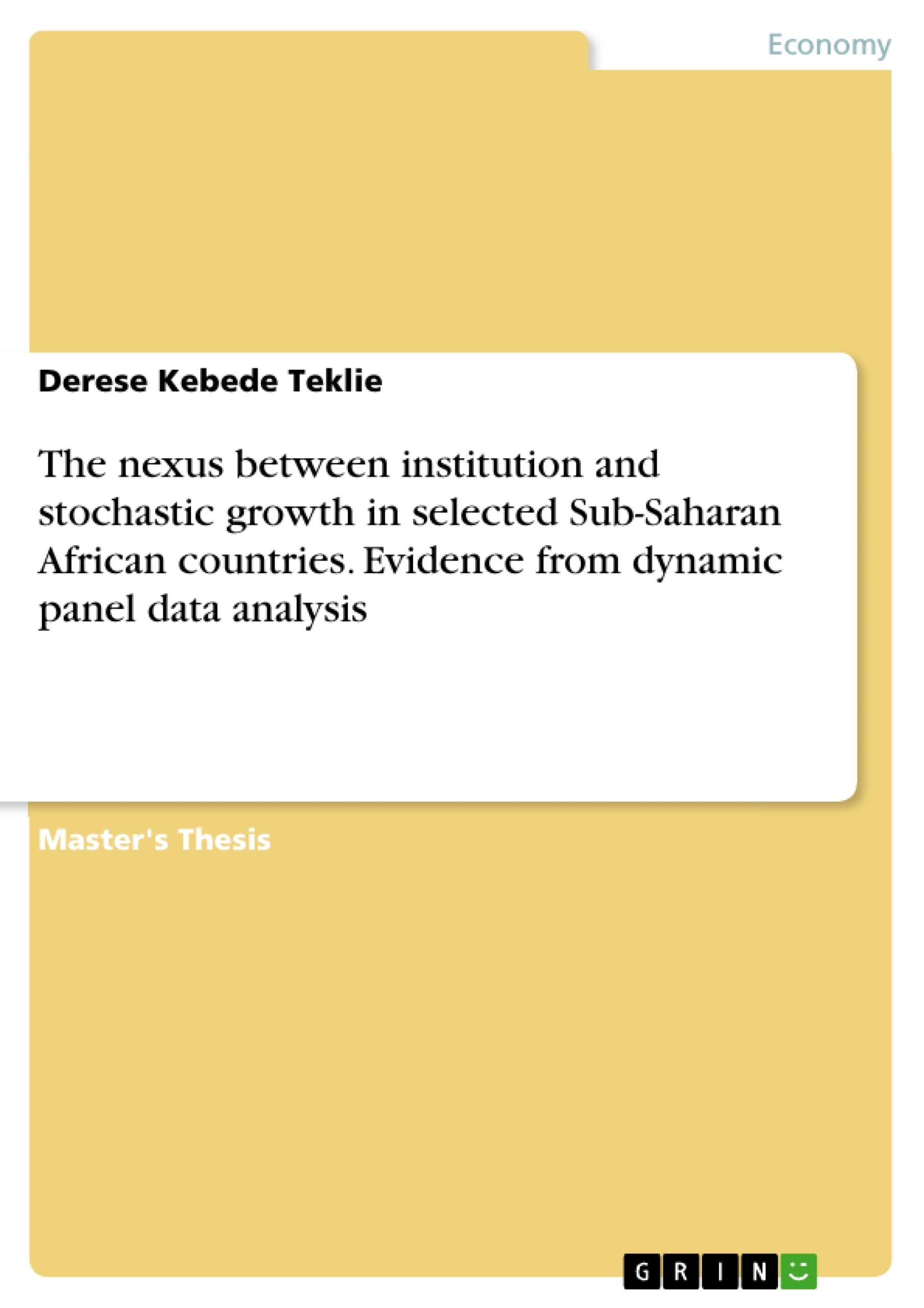Sub Saharan Africa economic growth shows a stochastic growth performance in which highly interrelated with faulty and fragile governance problems associated in the region. Accordingly, this thesis examines the contribution of formal institution explained by aggregated index for the six governance clusters measured by World Governance Indicator and individual level of each indicator on the stochastic growth behavior of selected SSA countries using data from forty two SSA countries over a period of 1996 to 2014.
To examine the impact of institution and level of good governance, the study employed Arellano-Bond (1991) and Arellano-Bover (1995) dynamic panel generalized method of moments (GMM) technique of estimation. The estimated result suggested that variables such as foreign aid, public investment, consumption, imported capital good, inflation, control of corruption, rule of law, voice and accountability, political stability, government effectiveness, regulatory quality and the aggregate index governance measures (institution) are significant and positively contribute to stochastic growth performance in the region across each models. On the other hand, outward trade policy negatively contributes to SSA Stochastic growth behavior.
In addition, the study surprisingly resulted that though foreign direct investment has no significant contribution in the study period its impact is negative in the region. A major policy implication arising from the results is that the advancement of institution and individual level of good governance are fundamental to the realization of sustained economic growth in SSA.
Inhaltsverzeichnis (Table of Contents)
- CHAPTER ONE: INTRODUCTION.
- 1.1. Background
- 1.2. Problem Statement.
- 1.3. Objectives
- 1.4. Research Questions
- 1.5. Hypothesis......
- 1.6. Justification
- 1.7. Significance......
- 1.8. Scope and Limitation of the study
- 1.9. Organization of the paper...
- CHAPTER TWO: LITERATURE REVIEW.
- 2.1. Theoretical Literature.....
- 2.1.1. Definition of Institution
- 2.1.2. Institutional Theory...
- 2.1.3. Stochastic Growth Theory
- 2.1.3.1. The Brock-Mir man Stochastic Growth Model
- 2.1.3.2. Real Business Cycle Model
- 2.1.4. The Nexus between Institution and Stochastic Growth.
- 2.2. Empirical Literature.
- 2.3. Conceptual Frame work..\li>
- CHAPTER THREE: METHODOLOGY.....
- 3.1. Model Specification.
- 3.2. Nature and Data source.
- 3.2.1. Data Source
- 3.2.2. Variable Definition
- 3.3. Estimation Techniques and Method of Analysis
- 3.3.1. Method of Analysis
- 3.3.2. Estimation Techniques.
- CHAPTER FOUR: DISCUSSION AND ANALYSIS..\li>
- 4.1. Data description and Summary statistics.
- 4.2. Econometric Results
- 4.2.1. Discussion, Interpretation and Analysis.
- 4.2.2. Post Estimation Test
- 4.2.2.1. Autocorrelation ....
- 4.2.2.2. Over identifying Restrictions.
- 4.2.2.3. Heteroscedasticity
Zielsetzung und Themenschwerpunkte (Objectives and Key Themes)
This thesis investigates the nexus between institutions and stochastic growth in selected Sub-Saharan African countries. The study aims to analyze the impact of institutional quality on economic growth, considering the influence of stochastic factors. The research employs dynamic panel data analysis to assess the relationship between institutional variables and economic growth, controlling for other relevant factors.
- The impact of institutional quality on economic growth in Sub-Saharan African countries
- The role of stochastic factors in influencing economic growth
- The nexus between institutions and stochastic growth
- The use of dynamic panel data analysis to estimate the relationship between institutional variables and economic growth
- Policy implications for improving institutional quality and fostering economic growth in Sub-Saharan Africa
Zusammenfassung der Kapitel (Chapter Summaries)
The thesis begins by outlining the research problem, objectives, and hypotheses in Chapter 1. Chapter 2 reviews the theoretical and empirical literature on institutions, stochastic growth, and the nexus between them. The methodological framework, including model specification, data sources, and estimation techniques, is presented in Chapter 3. Chapter 4 presents the results of the empirical analysis, including data description, econometric estimations, and post-estimation tests. The study concludes with a discussion of the key findings and their policy implications for promoting sustainable growth in Sub-Saharan Africa.
Schlüsselwörter (Keywords)
The study focuses on the relationship between institutions and stochastic growth in Sub-Saharan African countries, examining the impact of institutional quality on economic growth. Key concepts include institutional quality, stochastic growth, dynamic panel data analysis, Arellano-Bond GMM estimator, Arellano-Bover GMM estimator, and Sub-Saharan Africa.
- Quote paper
- Derese Kebede Teklie (Author), 2016, The nexus between institution and stochastic growth in selected Sub-Saharan African countries. Evidence from dynamic panel data analysis, Munich, GRIN Verlag, https://www.grin.com/document/354829



